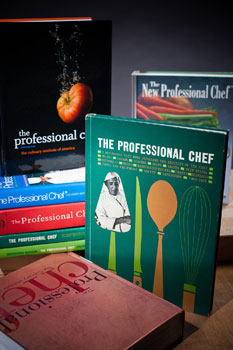Appealing to Kids’ Senses
 When teaching the development of successful children’s menus, emphasize to your students that all five human sensory perceptions (and an arguable sixth) must be put into play.
When teaching the development of successful children’s menus, emphasize to your students that all five human sensory perceptions (and an arguable sixth) must be put into play.
By Eric Stein, RD, MS, CCE
Getting kids to eat a nutritious meal doesn’t have to be a challenge. Just as there’s no one-size-fits-all learning style in the classroom, kids don’t respond to food stimuli the same way, either. Each child is born with a dominant sense that guides his or her food choices.
Appealing to the senses has a direct bearing on parents’ success getting kids to eat enough of the right foods. And while it is commonly perceived that we eat with our eyes first, aroma and sound also play vital roles in building hunger.
The following recipes are not only visually striking and flavorful, but also appeal to the senses of smell, touch (including texture and mouthfeel) and/or sound:

 For millennia, specific ingredients indigenous to traditional sheep-growing regions have influenced the types of dishes made using lamb, and today, popular techniques cross global frontiers for many cuts to yield eminently flavorful and satisfying dishes.
For millennia, specific ingredients indigenous to traditional sheep-growing regions have influenced the types of dishes made using lamb, and today, popular techniques cross global frontiers for many cuts to yield eminently flavorful and satisfying dishes. The “healthful” food label gets taken to new levels through nationwide cooperation, resulting in up-and-coming heirloom whole-grain breads and leafy breakfast salads and the well-established veggie-burger revolution.
The “healthful” food label gets taken to new levels through nationwide cooperation, resulting in up-and-coming heirloom whole-grain breads and leafy breakfast salads and the well-established veggie-burger revolution. The Professional Chef continues to change the world of cooking.
The Professional Chef continues to change the world of cooking. Moti Mahal Delux, a legendary high-end restaurant chain that is responsible for the invention of tandoori chicken, operates more than 100 locations throughout India, Nepal and London. This year, chef Gaurav Anand, a native of Punjab, India, has opened the restaurant’s first U.S. location, bringing the flavorful cuisine of the Mughal Empire to Manhattan’s Upper East Side.
Moti Mahal Delux, a legendary high-end restaurant chain that is responsible for the invention of tandoori chicken, operates more than 100 locations throughout India, Nepal and London. This year, chef Gaurav Anand, a native of Punjab, India, has opened the restaurant’s first U.S. location, bringing the flavorful cuisine of the Mughal Empire to Manhattan’s Upper East Side. Good practices of social-media conversation honor five key principles just as they do within teams and in kitchens.
Good practices of social-media conversation honor five key principles just as they do within teams and in kitchens. Easy, free and completely impartial, an assignment board guarantees that everyone shares equally in the assignments over a few days. Say these educators, the system is beautiful in its simplicity.
Easy, free and completely impartial, an assignment board guarantees that everyone shares equally in the assignments over a few days. Say these educators, the system is beautiful in its simplicity. Produced for only $0.88 a gallon to operate the college’s vehicles, the savings from converting cooking oil to fuel rather than purchasing regular diesel is huge.
Produced for only $0.88 a gallon to operate the college’s vehicles, the savings from converting cooking oil to fuel rather than purchasing regular diesel is huge. The Culinary Institute of America (CIA) is launching a new major in Culinary Science beginning in February 2013—one of a series of new academic programs in bachelor’s-degree studies at the college. The programs will advance the culinary profession and position CIA graduates for career success in the dynamically evolving foodservice industry.
The Culinary Institute of America (CIA) is launching a new major in Culinary Science beginning in February 2013—one of a series of new academic programs in bachelor’s-degree studies at the college. The programs will advance the culinary profession and position CIA graduates for career success in the dynamically evolving foodservice industry.